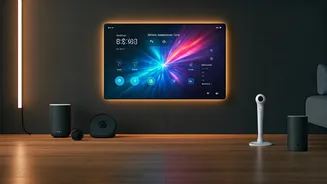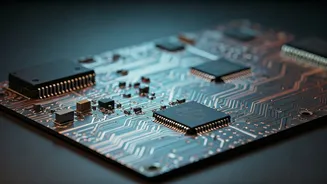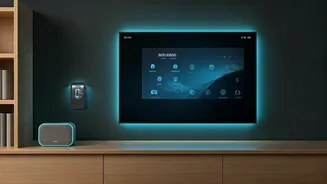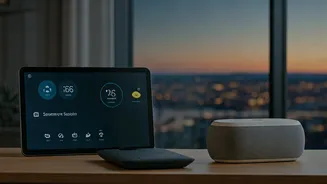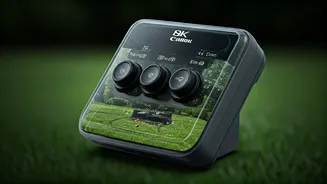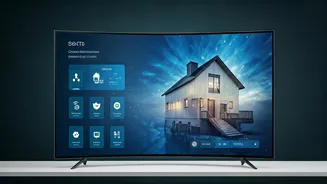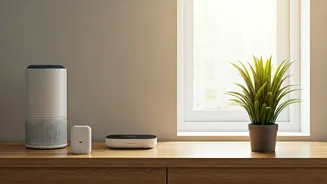Smart Home Basics
Smart homes are rapidly evolving, characterized by interconnected devices that communicate and automate tasks. The central hub, often a smart speaker or
a dedicated device, allows for control via voice commands or a smartphone app. These systems enable you to manage various aspects of your home, like lighting, temperature, and security, creating a convenient and often energy-efficient environment. Integration is a key aspect; products from different manufacturers can often be linked together through platforms like Amazon Alexa, Google Assistant, or Apple HomeKit. For instance, you could set up your smart lights to turn on automatically at sunset or your thermostat to adjust based on your daily schedule. This interconnection allows for tailored experiences that enhance comfort and security while potentially lowering energy expenses. Setting up a smart home involves choosing compatible devices, connecting them to your Wi-Fi network, and configuring the control system according to your preferences.
Smart Assistants Revealed
Smart assistants, such as Amazon's Alexa and Google Assistant, represent the cornerstone of many smart home setups. These devices utilize voice recognition to respond to your commands, playing music, answering questions, or managing your smart appliances. These tools serve as a centralized hub, allowing you to control different functions using just your voice. You can ask your smart assistant to turn off the lights, lock the doors, or check the weather. Beyond basic controls, smart assistants are also capable of providing information, setting reminders, and managing to-do lists. The market offers a range of smart assistants, including smart speakers and smart displays with screens. Selecting the right one for your home depends on your specific needs and the ecosystem you prefer to use. You should consider factors such as sound quality, screen size (if applicable), and integration with other devices when making your choice. Regular updates to both the hardware and the software, ensure enhanced performance, and keep you safe from cybersecurity threats.
Security for Peace
Home security systems are a major application of smart home technology. These systems incorporate elements like door and window sensors, security cameras, and smart locks, working to protect your home from intrusion. Many systems can send alerts to your smartphone when activity is detected, enabling you to keep an eye on your home from anywhere. Smart cameras, with their motion detection and video recording capabilities, can be placed indoors and outdoors to monitor activity and provide evidence if necessary. Smart locks allow you to lock and unlock your doors remotely and often offer keyless entry, enhancing both security and convenience. Professional monitoring services are available that will alert the authorities when a break-in is detected. With the evolving capabilities, homeowners have greater control and awareness over their home's security, creating a more secure living environment. These security measures, combined with easy access to mobile alerts, significantly boost the security of homes and provide residents with more control over their spaces.
Smart Home Appliances
Smart appliances take the concept of a connected home to a new level, offering features that improve convenience and efficiency. Smart refrigerators can have built-in screens, allowing you to manage your grocery list or even watch videos. Smart ovens can be controlled remotely, letting you preheat them on your way home from work. Washing machines and dryers often include Wi-Fi connectivity, letting you start or monitor the laundry cycle remotely. These appliances typically offer energy-saving features, such as optimized cycles and remote power-off capabilities. They also provide detailed usage reports, helping you monitor energy consumption and make adjustments as needed. Smart appliances often integrate with other smart home systems, creating a seamless and automated experience. For example, your smart oven could automatically preheat when your smart thermostat senses that you're approaching home. The possibilities of smart appliances are constantly expanding, improving both convenience and sustainability in the home.
Home Automation Insights
Home automation goes beyond individual smart devices by integrating them into a cohesive system. Automation involves setting up rules or scenes that trigger actions based on certain conditions. For example, you can set your lights to turn on automatically when the sun sets or activate your security system when you leave the house. Smart home hubs like the Samsung SmartThings Hub or Hubitat Elevation are designed to manage all connected devices. These hubs use different communication protocols like Z-Wave, Zigbee, and Wi-Fi to ensure compatibility across a wide range of devices. Automation scenarios can be as complex as controlling every aspect of your home environment. You might create a 'movie night' scene where the lights dim, the curtains close, and the TV turns on with a single voice command. Home automation offers the flexibility to tailor your smart home to your lifestyle, enhancing comfort and ease of use. Through the use of automation, homes become more responsive to your needs, adapting seamlessly to the rhythm of your daily routine.
Best Smart Home Gear
Choosing the best smart home gear depends on your needs and budget. Top-rated smart assistants include Amazon Echo and Google Nest Audio. Smart security systems, like those from Ring and SimpliSafe, offer reliable protection and are user-friendly. When it comes to lighting, Philips Hue is a popular choice for its color-changing bulbs and compatibility with other smart home platforms. Smart thermostats, such as the Nest Learning Thermostat and ecobee, are great for saving energy and customizing your home's climate. The best products offer a balance of features, ease of use, and compatibility with various smart home ecosystems. Look for products that integrate seamlessly with your existing devices and are easy to set up and manage. Reading user reviews and comparing features will help you identify the best options for your specific needs. It's smart to start with a few essential devices and build your smart home gradually, adding more devices as you become more comfortable with the technology. This approach allows you to explore different options and customize your smart home setup.
